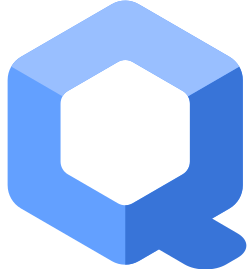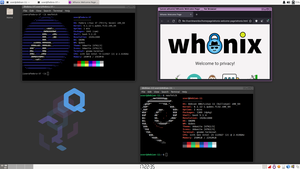 | |
 | |
| Developer | The Qubes OS Project
Invisible Things Labs Joanna Rutkowska |
|---|---|
| OS family | Linux (Unix-like) |
| Working state | Current |
| Source model | Open source with proprietary blobs,[1][2] |
| Initial release | September 3, 2012[3] |
| Latest release | 4.2.3 |
| Marketing target | security by compartmentalization, desktop, laptop |
| Available in | Multilingual |
| Update method | DNF (PackageKit) |
| Package manager | RPM Package Manager |
| Platforms | x86-64 |
| Kernel type | Microkernel (Xen Hypervisor running minimal Linux-based OSes and others) |
| Userland | GNU[note 1] |
| Default user interface | Xfce |
| License | Free software licenses (mainly GPL v2[4]) |
| Official website | qubes-os |
Qubes OS is a security-focused desktop operating system that aims to provide security through isolation.[5] Isolation is provided through the use of virtualization technology. This allows the segmentation of applications into secure virtual machines called qubes. Virtualization services in Qubes OS are provided by the Xen hypervisor.
The runtimes of individual qubes are generally based on a unique system of underlying operating system templates. Templates provide a single, immutable root file system which can be shared by multiple qubes. This approach has two major benefits. First, updates to a given template are automatically "inherited" by all qubes based on it. Second, shared templates can dramatically reduce storage requirements compared to separate VMs with a full operating install per secure domain.
The base installation of Qubes OS provides a number of officially supported templates based on the Fedora and Debian Linux distributions. Alternative community-supported templates include Whonix, Ubuntu, Arch Linux, CentOS, or Gentoo.[6] Users may also create their own templates.
Operating Systems like Qubes OS are referred to in academia as Converged Multi-Level Secure (MLS) Systems.[7] Other proposals of similar systems have surfaced[8][9] and SecureView and VMware vSphere are commercial competitors.[citation needed]
- ^ "Will Qubes seek to get certified under the GNU Free System Distribution Guidelines (GNU FSDG)?".
- ^ "Qubes OS License".
- ^ "Introducing Qubes 1.0!". September 3, 2012.
- ^ "License Qubes OS". www.qubes-os.org.
- ^ "Qubes OS bakes in virty system-level security". The Register. September 5, 2012.
- ^ "Qubes OS Templates".
- ^ Issa, Abdullah; Murray, Toby; Ernst, Gidon (December 4, 2018). "In search of perfect users: towards understanding the usability of converged multi-level secure user interfaces". Proceedings of the 30th Australian Conference on Computer-Human Interaction. OzCHI '18: 30th Australian Computer-Human Interaction Conference. Melbourne Australia: Association for Computing Machinery (ACM). p. 572576. doi:10.1145/3292147.3292231. ISBN 978-1-4503-6188-0. Retrieved November 1, 2020.
- ^ Beaumont, Mark; McCarthy, Jim; Murray, Toby (December 5, 2016). "The cross domain desktop compositor: using hardware-based video compositing for a multi-level secure user interface". Proceedings of the 32nd Annual Conference on Computer Security Applications. ACSAC '16: 2016 Annual Computer Security Applications Conference. Los Angeles California USA: Association for Computing Machinery (ACM). p. 533545. doi:10.1145/2991079.2991087. ISBN 978-1-4503-4771-6. Retrieved November 1, 2020.
- ^ Atanas Filyanov; Nas, Aysegül; Volkamer, Melanie (July 1, 2013). "Poster: On the Usability of Secure GUIs". p. 11. S2CID 17605611.
{{cite web}}: Missing or empty|url=(help)
Cite error: There are <ref group=note> tags on this page, but the references will not show without a {{reflist|group=note}} template (see the help page).